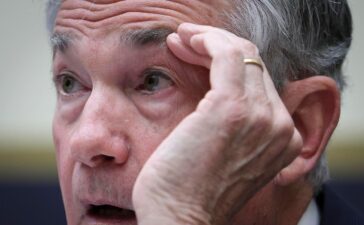Asia’s central bankers are bracing for more turbulence from a stronger US dollar as the receding prospect of US interest rate cuts this year sends shockwaves through the yen, renminbi and other regional currencies.
Policymakers in Japan, China and South Korea have all talked up the stability of their currencies in recent days as they weaken under the intense pressure of the gap between the US’s high rates and the low rates that underpin Asia’s biggest economies.
Investors’ flight to higher-yielding US assets has sent the yen to a 34-year low past ¥154 to the dollar and has also tested Beijing’s stable currency policy as the renminbi’s value to the dollar fell below the central bank’s daily reference rate. The won hit its weakest level against the greenback since November 2022.
The volatility prompted policy moves ranging from a rare joint statement by the US, Japan and South Korea on Thursday addressing “serious concerns . . . about the recent sharp depreciation of the Japanese yen and the Korean won” to warnings from the Chinese central bank against “one-sided” renminbi bets.
But analysts said the warnings, from the US and Japan in particular, only highlighted the limited chance that their governments would intervene.
“It is like ‘we hear you but there is not much we can do,’” said Paul Mackel, global head of FX research at HSBC, said. “The old phrase by former US Treasury secretary John Connally that ‘the dollar is our currency, but it’s your problem’ still rings true again today,” he added.
At the start of the year, Asian policymakers were more confident that a series of US interest rate cuts would ease the strain of the rate gap. Three months of higher than expected US inflation data and a resilient economic performance have put paid to that plan.
“Fast forward to today and central bankers in Asia can’t really at least currently [count on] a weaker US dollar and [Federal Reserve] rate cuts,” said Adarsh Sinha, head of the Asia rates and currencies strategy team at Bank of America.
The week’s statements have also pointed to the limits of central bankers’ ability to direct markets and signal policy intentions with subtle verbal public comments.

Traders in Tokyo said that the joint statement by the US, Japan and South Korea, though it appeared historic, was a relatively “cheap” option for all three countries — designed to spook the market enough to calm things down, but not actually making intervention more likely.
Junya Tanase, an analyst at JPMorgan Chase, said even unilateral moves into the market were rare as all G7 members had a free-floating currency. “In the past, there have been some joint interventions conducted under the G7 framework,” he said. “Joint interventions tend to be more exceptional and only conducted in crisis.”
Bank of Japan governor Kazuo Ueda, however, signalled this week that the central bank could raise interest rates if the impact of the weaker yen became “too big to ignore”, marking an unusual and strong verbal stance by the BoJ.
Short positions in the yen, say traders, have remained at their highest level since 2007, suggesting that speculators have yet to be scared off by official warnings.
China’s policymakers are meanwhile facing a dilemma over how far to relax controls over how much the renminbi can move, trying to navigate economic doldrums at home and complaints by trading partners that China is dumping cheap exports on their economies.
When President Xi Jinping laid out China’s biggest financial priorities to Communist party cadres at the start of this year, “a strong currency” topped the list. In recent weeks, the People’s Bank of China has been fighting market bets that the renminbi will weaken further because of the gap between low Chinese interest rates and higher US ones.
Markets have been testing the PBoC’s linchpin daily fixing of the renminbi against the US dollar by pricing the currency at the lower end of a band that is allowed to move up to 2 per cent in either direction per day. Trading of the renminbi offshore has meanwhile already breached this band. China’s central bank has been pushing back by not fixing the onshore currency at the lower market price.
Its move had also been supplemented by a sharp rise in the costs to fund bets on further weakness in the offshore renminbi, traders said. The rate Chinese state banks set to borrow from each other for a week rose more than 5.3 per cent this week, up from 2.8 per cent a month ago.
But, equally, traders believe a strong renminbi against other Asian currencies could hurt Chinese exports to the region. Exports are soaring, according to statistics, as supply chains shift to third countries in Asia between the US and China.
“The main trigger is still the Fed and a stronger dollar,” said a Shanghai-based renminbi trader at a Chinese state bank. “But, more importantly, this time is because the yen has depreciated so much — without any intervention from the Bank of Japan. That forced us to follow through.”
Strategists also pointed out that the Chinese currency has historically been influenced by the US dollar’s performance against the euro. The single currency is dominant in the basket of currencies that make up Beijing’s main trading partners.
“It has always been the case that the People’s Bank of China will allow the renminbi to weaken against the dollar if the dollar is strengthening against the euro,” said David Lubin, senior research fellow at Chatham House and former head of emerging market economics at Citigroup.
The official CFETS renminbi index, which measures the currency’s performance versus 24 peers including the yen and won, has climbed 2.7 per cent since last year and this week rallied to its highest level in a year.
Zhu Hexin, PBoC vice-governor and head of the State Administration of Foreign Exchange, the manager of China’s FX reserves, warned markets this week that “the central bank is determined and unwavering in its stance to keep the relative stability of the yuan rate”.
Others doubt it will change its overall policy. “There is no sign that the PBoC will change its course anytime soon,” said Chen Long, co-founder of Plenum, a Beijing-based research company. “China’s export volume growth has been strong, and its real exchange rate is near its lowest level in a decade.”
Analysts say that China’s experience in 2015 looms behind its current policy. Nine years ago, an economic scare triggered a stock market plunge, capital flight and a sharp depreciation in the renminbi. China’s foreign exchange reserves fell by $1,000bn to $3,000bn. These reserves largely remain at this level today but have been supplemented with other assets, such as state bank cash, giving China additional firepower in the currency market.
BofA’s Sinha said that the central bank had learned from the experience of a disorderly rout and had options available. “The PBoC can engineer an orderly depreciation if they so wanted,” he said. “It sounds like for the time being they want to keep currency stability.”















